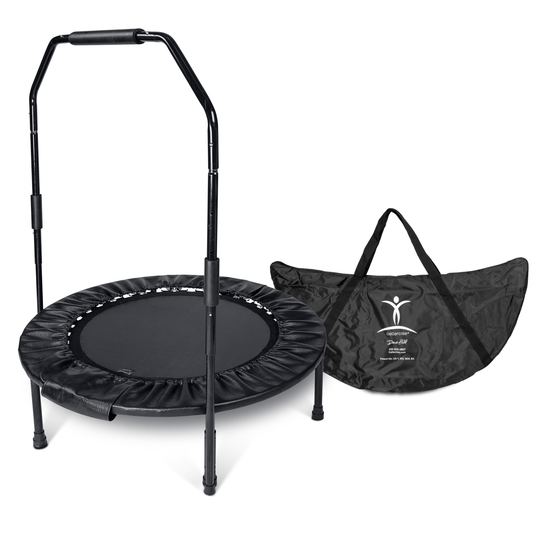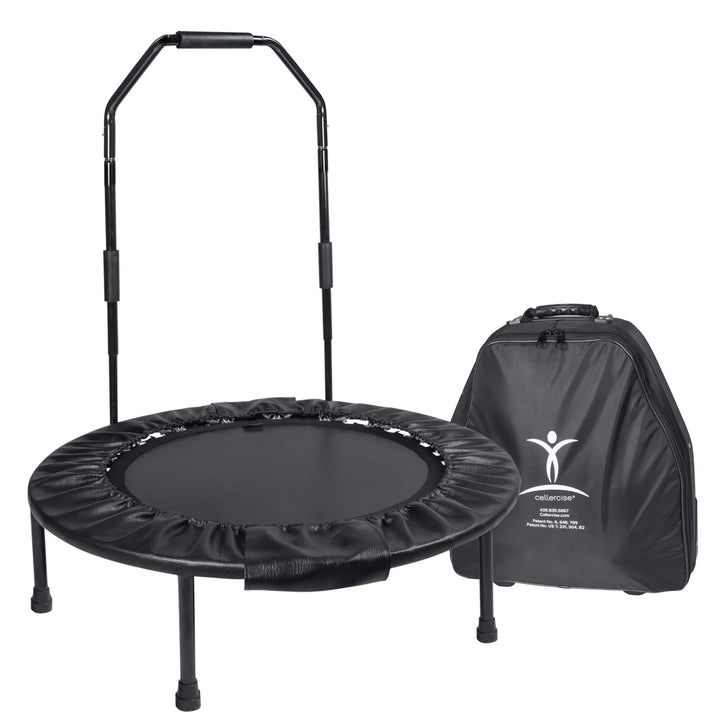Rebounding vs. Walking for Your Health.
Disclaimer: This Blog/Web Site is made available by the publisher for educational purposes only as well as to give general information & understanding regarding the industry. It is not to be used as specific medical advice or to replace consulting with your doctor. You should always consult with your doctor. By using this Blog / Web Site you understand that this Blog/Web Site should not be used as a substitute for medical advice from a licensed professional. For our full disclaimer, please read: Cellercise® Disclaimer
If you’re looking for a low-impact workout to help you lose weight and stay in shape, walking may seem like the ideal choice. Walking helps the body in several ways, from improving metabolism and burning calories to strengthening the joints and toning various muscle groups. But it can be improved. While the benefits of walking are vast, they mostly involve maintenance and not real change. Rebounding may be the answer for those looking for low impact exercise that will help them lose weight and boost their metabolism.
Rebounding is becoming one of the most popular forms of low-impact exercise for several reasons. Many believe it’s better than walking for overall health – and all you need is a mini trampoline.
What Do Walking and Rebounding Have in Common?
If you’re thinking of ways to enhance your workout routine or want to start a new routine to lose weight and get in shape, then both rebounding and walking have significant benefits. Ideally, you should add both to your daily routine, but modern life is demanding and not everyone has a flexible enough schedule to do so.
If you’re wondering what rebounding and walking have in common, there are several similarities:
- Both exercises are low impact. You don’t need to worry about overstressing your muscles and joints with these exercises. Walking is the type of exercise that you should do at your own pace, both in terms of speed and distance. The same goes for rebounding; most people benefit from just ten minutes of bouncing per day, but some may require less while others want a more intense workout and may rebound for 15 minutes or more.
- Rebounding and walking are both great ways to build a calorie deficit. The golden rule of weight loss is to burn more calories each day than you consume. Both rebounding and walking are easy ways to burn additional calories and they don’t need to be long, drawn-out exercises. Ten minutes of each or either per day can be enough to tip you into calorie deficit territory so you can start seeing weight loss results.
- Both are inexpensive. While rebounding requires an investment into a high-quality mini trampoline, walking is essentially free. Both are much cheaper than investing in a gym membership or purchasing home workout equipment.
- Both exercises are great for all ages and almost all health levels. Rebounding and walking are accessible, easy for virtually anyone to do, and provide a wide range of health benefits to a variety of people. Everyone from children to seniors can enjoy healthier lifestyles thanks to these exercises, and it’s simple to tailor a workout plan to an individual’s needs and overall health.
- You can do both at home. If you’re willing to invest in a treadmill you can walk for however long you want from the comfort of your own home. This can be great if you live in an area with severe winter weather or other climate conditions that make walking outside unenjoyable. As long as you have a high enough ceiling you can set up a mini trampoline almost anywhere in your home, too.
- You can change things up easily with both exercises. Walking a new route can help break the monotony of your daily strolls and performing new movements while rebounding can be both fun and an effective workout strategy.
Both walking and rebounding are great exercises with significant benefits, but you’re probably wondering what separates these two exercises if you’re interested in focusing on just one.
Differences Between Walking and Rebounding
While walking and rebounding share many of the same benefits, they each also offer unique perks that everyone should consider. As you develop your exercise routine, consider some of the major differences between rebounding and walking.
- Rebounding is more stationary. Unless you intend to purchase a treadmill to get your steps in at home, rebounding is a more stationary exercise. You will not travel very far, but you will certainly be moving quite a bit. If you like the idea of getting outside and seeing more of the outdoors during your workouts, you might prefer walking.
- Rebounding can be a more intense workout. Walking and rebounding both work many of the same lower body muscle groups, but rebounding will put slightly more stress on the body overall. For example, a ten-minute rebounding session may make you feel as tired as a 30-minute walk.
- You’ll need to buy equipment for rebounding. You’ll need to invest in a mini trampoline if you want to start rebounding. However, the fun and diverse range of health benefits rebounding offers generally leads many who invest in them to consider them well worth the price.
- Rebounding burns more calories. On average, a 30-minute rebounding session will burn significantly more calories than a 30-minute walk. If you’re trying to decide which exercise will boost your calorie deficit and improve your weight loss, then rebounding is probably the way to go.
- While walking is one of the least impactful exercises, it’s still jarring to the body and can shatter the nervous system, working against our natural upright gaits.
Dr. Paul E. Devore says trampolining can burn calories up to 11 times faster than walking. The advantage of using a Cellerciser® is that it doesn't cause impact strain in the lower back. Movement from using the Cellerciser® helps the hips to drop using lower lumbar. The pumping action the Cellerciser® creates essentially provides the benefits of walking without the tension walking can cause in the joints.
Adding Walking and Rebounding to Your Exercise Routine
Everyone is different, and different health needs and goals require different solutions. You might find walking to be more enjoyable but rebounding more effective, or vice versa. You may also discover that you thoroughly enjoy doing both exercises and develop an exercise routine that incorporates rebounding and walking.
You can also marry the two with the Jamba Walk program. Get all the benefits of walking with the help of the Cellerciser® to help you accomplish your goals.
Remember that the content of this article is to inform and encourage you to try new methods of getting in shape with a Cellerciser®. This content is not medical advice, nor is it intended to help treat any specific ailment or condition. Whatever you decide, make sure to start slow and speak to your doctor about both exercises to minimize your risk of injury and to maximize the effectiveness of your daily exercise routines.
NOTE: Remember to always consult with your doctor or health professional before starting new exercise routines.
Get Your Cellerciser® and start rebounding today!














